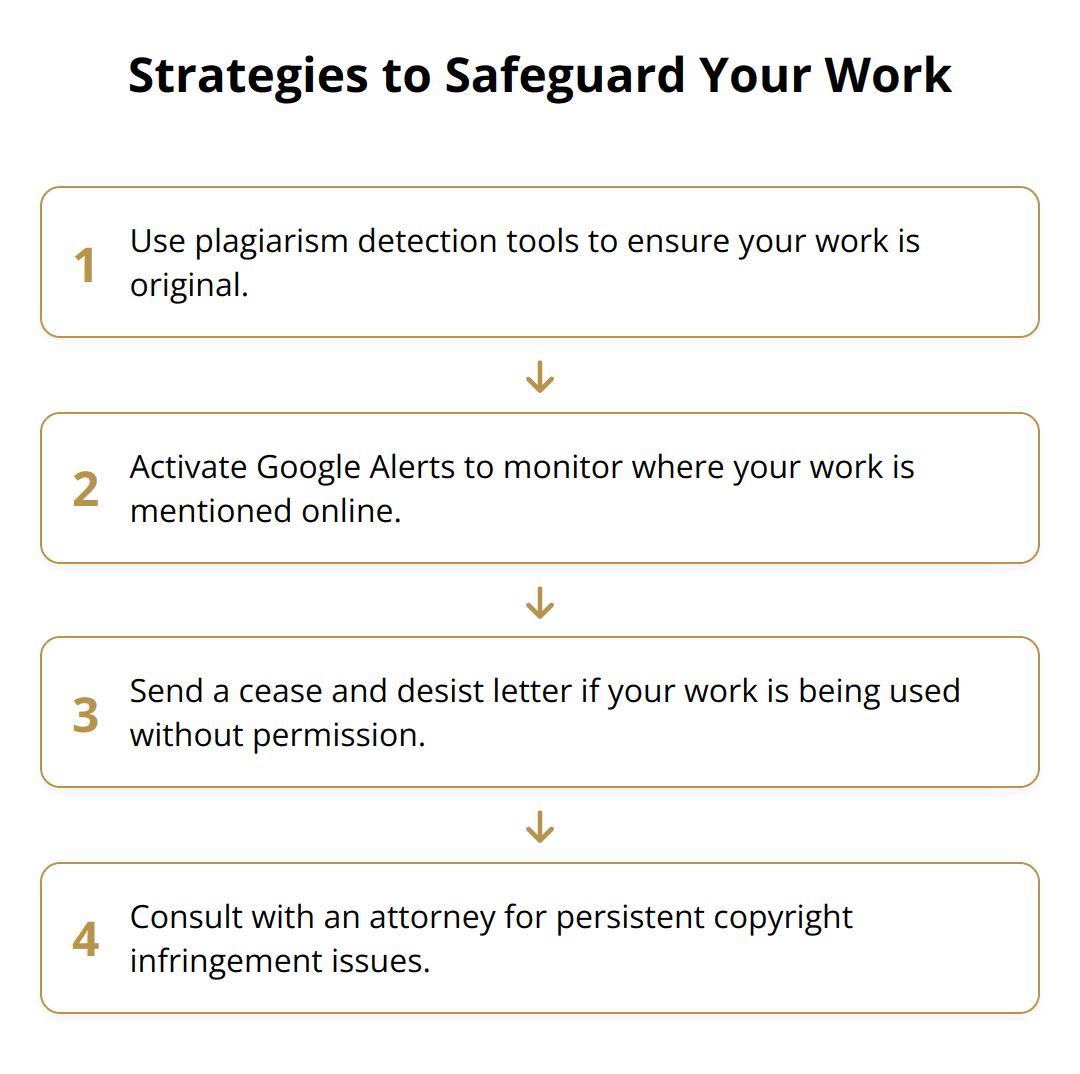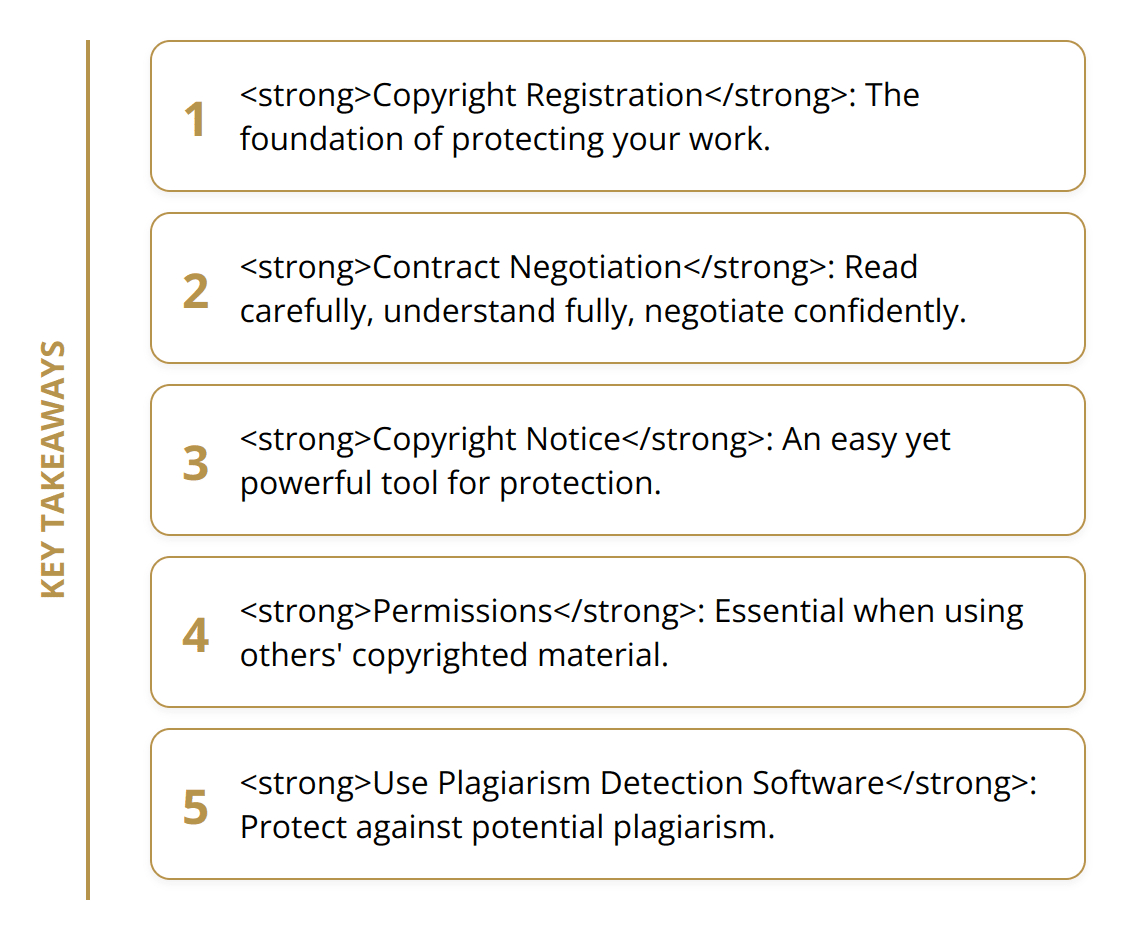by Andrea Albright

At Beverly Hills Publishing, we understand that intellectual property is the backbone of any author’s career. It’s essential to grasp its basics, protect your work, and navigate common challenges effectively.
This blog post aims to equip authors with the knowledge and tools necessary for safeguarding their intellectual assets. We’ll explore everything from copyright registration to resolving disputes, ensuring your creative endeavors are well-protected.
Navigating Intellectual Property for Authors
In the literary world, the importance of understanding and protecting your intellectual property cannot be overstated. Here are key insights and actionables that every author should consider to safeguard their creative works.
Intellectual Property Explained
Intellectual Property (IP) refers to creations of the mind such as novels, poems, and articles. It gives authors legal rights to their works, ensuring they can control and benefit from their creation.
Vital IP Rights for Authors
Authors should focus primarily on three types of IP rights:
- Copyright: It is the most critical IP right for authors. It protects original literary works, granting authors the exclusive right to use, reproduce, distribute, and display their creations. Remember, copyright protects the expression of ideas, not the ideas themselves. The moment you pen down your thoughts, copyright protection kicks in. However, registering with the U.S. Copyright Office bolsters your legal standing, facilitating easier enforcement.
- Trademarks: These protect brand elements associated with your work, such as titles, series names, and character names. While not as common for authors, trademarking can be vital if you’re developing a brand around your series or character.
- Design Rights: These protect the visual appearance of your books, particularly cover designs. In an era where a book’s cover can significantly impact its marketability, design rights offer crucial commercial benefits.
Why IP Matters in Publishing
The digital age has made it easier than ever to distribute and access literary works. However, it’s also increased the risk of copyright infringement. Understanding and protecting your IP rights is not just about safeguarding your present work but ensuring you reap the benefits of your labor in the long run.

Practical Steps to Protect Your Work
- Register: Though copyright automatically protects your work, registration provides a public record, making it easier to enforce your rights.
- Trademark: Consider trademarking the names or logos associated with your series or characters, particularly if they have commercial value.
- Design Protection: Register the designs of your book covers if they are unique and critical to your brand.

Bringing It Together
Safeguarding your intellectual assets requires a proactive approach. By understanding the different types of IP relevant to your work and taking the necessary steps to protect them, you secure not just your current creations but also your future earnings and reputation in the publishing industry.
Following these guidelines ensures your literary creations are well-protected, allowing you to focus on what you do best: writing compelling stories.
Safeguarding Your Creative Legacy
Embarking on the journey of writing and publishing is both exhilarating and daunting. One of the most crucial steps in this process is ensuring your hard work and creativity are protected. In today’s digital age, the importance of safeguarding your intellectual property cannot be overstated. Below, we delve deeper into practical steps authors can take to secure their work.
Registering Copyright for Your Work
The first line of defense for any author is copyright registration. While it’s true that your work is automatically protected from the moment it’s created, registering with the U.S. Copyright Office provides a solid proof of ownership and a public record. This is invaluable in case of a dispute. The process is straightforward but pivotal. You’ll need to fill an application, pay a fee, and submit a copy of your work. Doing this sooner rather than later can save you from potential headaches down the line.
Navigating Copyright Agreements with Publishers
When it comes to working with publishers, read and understand the fine print. You might be surprised how many authors gloss over their contracts, only to regret it later. Pay close attention to the rights you are licensing to the publisher and for how long. Ensure you retain the rights to your work for adaptations or future editions. It’s not uncommon for authors to seek legal advice to navigate these waters. Remember, negotiation is key. If something doesn’t feel right, it’s likely because it isn’t. Stand firm on your rights.
Utilizing Copyright Notices and Permissions for Your Work
A simple yet effective tool in your arsenal is the copyright notice. This should appear in your book and any other published works, signaling to readers and would-be infringers that your work is protected. This notice typically includes the copyright symbol (©), the year of publication, and your name. Additionally, if you’re planning to use copyrighted material not owned by you, obtaining permissions is essential. This process can be time-consuming but it’s a legal requirement that can’t be overlooked.

By following these guidelines, authors can ensure their creative legacy is well protected, allowing them to focus on what they do best—crafting unforgettable stories. With the proper safeguards in place, your work will continue to inspire, entertain, and educate for generations to come.
- Copyright Registration: The foundation of protecting your work.
- Contract Negotiation: Read carefully, understand fully, negotiate confidently.
- Copyright Notice: An easy yet powerful tool for protection.
- Permissions: Essential when using others’ copyrighted material.
Handling IP Challenges
Authors face numerous intellectual property challenges, from plagiarism to copyright infringement. Understanding these challenges and adopting effective strategies is essential to safeguarding your work.
Navigating Plagiarism
Plagiarism, the act of using someone else’s work without permission or proper acknowledgment, is a significant concern for authors. To avoid plagiarism, always cite sources appropriately and use plagiarism detection tools. It’s also advisable to keep detailed records of your research and drafts, showcasing the evolution of your work. This can serve as evidence of originality if disputes arise.
Dealing with Copyright Infringement
Copyright infringement occurs when your work is used without authorization. It’s vital to monitor the use of your content actively. Tools like Google Alerts can help you track where your work is mentioned online. If you find your work being used without permission, send a cease and desist letter as an initial step. For persistent issues, legal action may be necessary. Consulting with an attorney who specializes in intellectual property can provide guidance on the best course of action.
Resolving Disputes
Disputes over intellectual property can be complex and require a strategic approach:
- Document Everything: Keep comprehensive records of your work’s creation and publication.
- Seek Legal Advice Early: An attorney can help navigate disputes and offer solutions.
- Consider Mediation: Before heading to court, mediation can be a less costly and quicker way to resolve disputes.
- Understand the Value: Knowing the commercial value of your work can help in negotiations.

Quick Tips:
- Regularly use plagiarism detection software.
- Activate Google Alerts for your published works.
- Always keep a paper trail of your creative process.
Intellectual property challenges can be daunting, but being proactive and prepared ensures your rights are protected, allowing you to focus on your passion for writing. Here are some tools to safeguard your copyright.
Final Thoughts
Navigating the complexities of intellectual property as an author is not just about legal compliance; it’s about valuing and protecting the essence of your creativity. Throughout this post, we’ve underscored the importance of copyright registration, trademark considerations, and design rights as foundational steps to defend your intellectual assets. These measures are not mere formalities but crucial steps to ensure that your voice as an author remains uniquely yours, legally recognized and respected.

The digital landscape, while offering unprecedented opportunities for authors to share their work, also presents new challenges in safeguarding intellectual property. Being proactive, from utilizing copyright notices to navigating copyright agreements thoughtfully, can make a significant difference in maintaining control over your work. The steps outlined offer a roadmap to not just react to challenges but to anticipate and address them effectively.
At Beverly Hills Publishing, we believe that every author deserves to see their work flourish without the looming threat of intellectual property infringement. We are dedicated to revolutionizing how authors succeed, intertwining exceptional publishing services with strategic branding and marketing that elevates your book beyond traditional platforms. Our holistic approach is designed to transform authors into authoritative figures in their industries, safeguarding their intellectual property while amplifying their voice globally.
Remember, protecting your intellectual property isn’t just about preserving what you’ve created; it’s about securing the future of your creative endeavors and establishing a legacy that withstands the test of time. As you continue to navigate the world of writing and publishing, let the insight from this post serve as your guide in making informed decisions that ensure your work is well-protected, respected, and celebrated for years to come.














































































